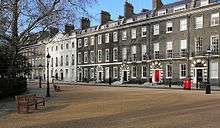Southampton Row



Southampton Row is a major thoroughfare running northwest-southeast in Bloomsbury, Camden, central London, England. The road is designated as part of the A4200.
Location
To the north, Southampton Row adjoins the southeast corner of Russell Square. To the south at Holborn tube station, it becomes Kingsway at the junction with High Holborn.
On the corner with Theobald's Road (part of the A401) is the complex that formerly housed Central Saint Martins College of Art and Design, and the Cochrane Theatre. There are several major hotels on Southampton Row, including the Bedford, DoubleTree by Hilton Hotel London - West End, and Holborn hotels.
History
The street was named after Thomas Wriothesley, 4th Earl of Southampton. It was previously known as Kingsgate Street.
In 1822 the Chartist Henry Hetherington registered a printing press at 13 Kingsgate Street—an eight-roomed house, including shop and printing premises—at an annual rent of £55.
The first studio of the sculptor Robert William Sievier (1794–1865) was in Southampton Row until 1837.
The Central School of Art and Design, formerly the Central School of Arts and Crafts, was established by the London County Council in 1896 in Southampton Row to provide specialist art teaching for workers in the craft industries. The architect William Lethaby (1857–1931) was the first Principal, as recorded by a blue plaque on Southampton Row.
Sir John Barbirolli, the conductor and cellist, was born in Southampton Row on 2 December 1899. A commemorative blue plaque was placed on the wall of the Bloomsbury Park Hotel in May 1993 to mark his birthplace.
In 1907 the Institute of Education moved to its first purpose-built building on Southampton Row.[1] In 1938 the Institute moved to the Senate House complex of the University of London on Malet Street, not far away to the northwest.[2]
On 12 September 1933 the Hungarian physicist Leó Szilárd, an exile from Nazi Germany, had an insight that changed the course of history as he crossed the pedestrian traffic lights at the junction of Southampton Row with Russell Square. He realised that splitting an atom with a neutron could produce further neutrons which themselves could also split atoms, leading to a chain reaction and a massive release of energy. This led directly to the development of the atomic bomb and nuclear energy.[3]
The Sue Ryder Care charity, established in 1953, is registered at 114–118 Southampton Row.
In 1966 the Indica Bookshop was separated from the Indica Gallery, a counterculture art gallery supported by Paul McCartney, and moved to 102 Southampton Row in the summer of that year.
The street formed part of a tram route that included a tunnel for trams. Nowadays it is a major bus route.
Olympic Road Network
Southampton Row formed part of the ORN (Olympic Road Network) for the London 2012 Olympic and Paralympic games, its designation causing some controversy.[4]
See also
- List of eponymous roads in London
- Southampton Street, Westminster, London
References
- ↑ Aldrich (2002). The Institute of Education 1902–2002. p. 35.
- ↑ Aldrich (2002). The Institute of Education 1902–2002. p. 110.
- ↑ Bronowski, Jacob (1973). The Ascent of Man. BBC Books. p. 369. ISBN 1849901155.
- ↑ Bond, Anthony (16 July 2012). "The Ridiculous Example". Daily Mail.
Coordinates: 51°31′11″N 0°07′20″W / 51.51972°N 0.12222°W
